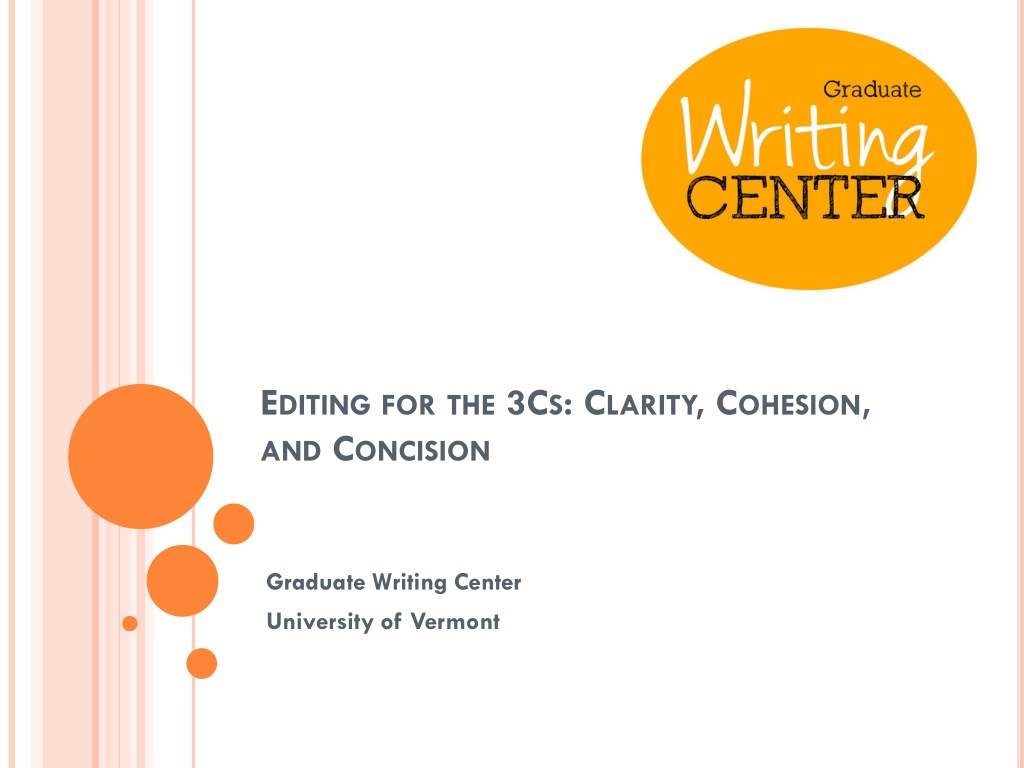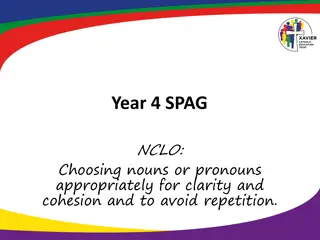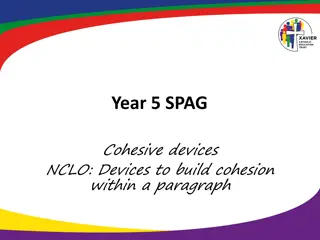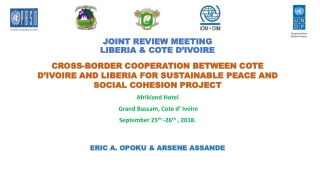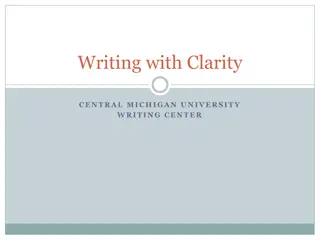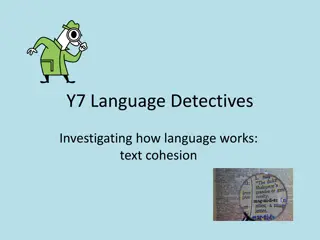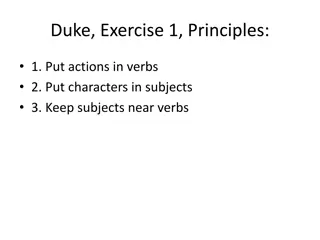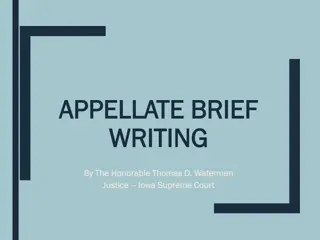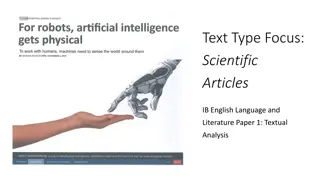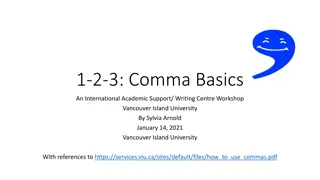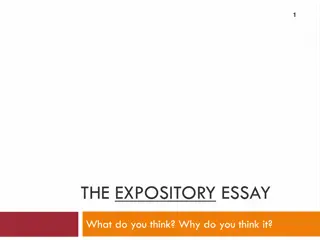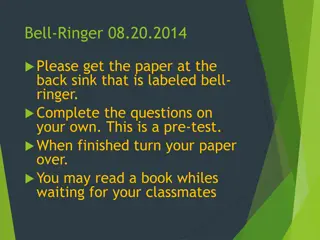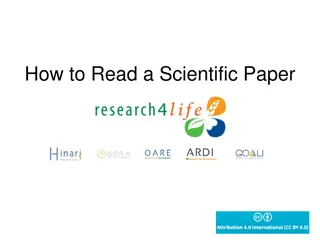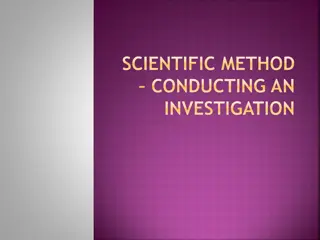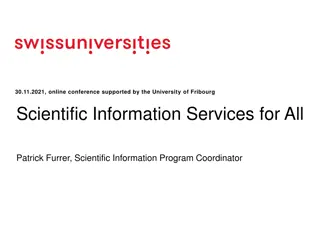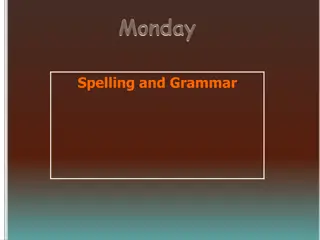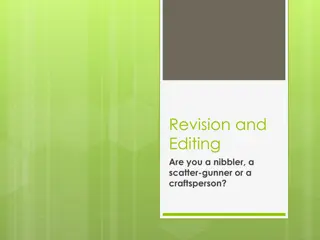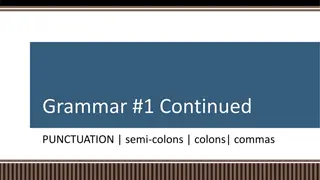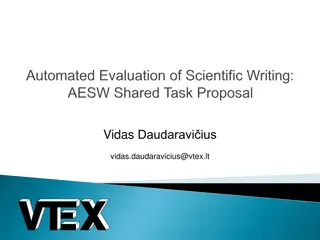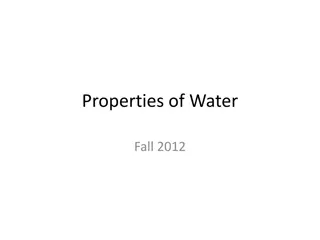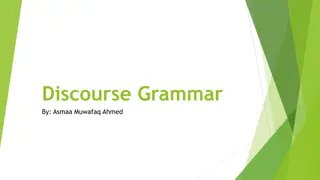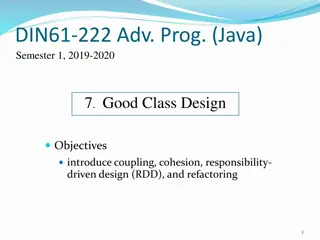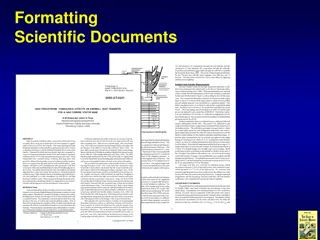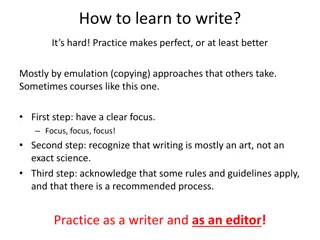Mastering Clarity, Cohesion, and Concision in Scientific Writing
Enhance your scientific writing by learning techniques to improve clarity, cohesion, and concision. Discover strategies to minimize distance between subjects and verbs, and optimize the flow from known to new information, illustrated with practical examples.
Download Presentation

Please find below an Image/Link to download the presentation.
The content on the website is provided AS IS for your information and personal use only. It may not be sold, licensed, or shared on other websites without obtaining consent from the author. Download presentation by click this link. If you encounter any issues during the download, it is possible that the publisher has removed the file from their server.
E N D
Presentation Transcript
EDITING FOR THE 3CS: CLARITY, COHESION, AND CONCISION Graduate Writing Center University of Vermont
FROM THE SCIENCE OF SCIENTIFIC WRITING BY GEORGE GOPEN AND JUDITH SWAN Information is interpreted more easily if it is placed where readers expect to find it : o The subject at or near the sentence s start o The verb placed close to the subject and communicating the sentence s action o Each sentence ending ( stress position ) with a bang what you want to stress and not a whimper o Each new sentence picking up where the previous sentence left off ( known to new information ) https://www.americanscientist.org/blog/the-long-view/the-science-of- scientific-writing
EXAMPLE 1, UNEDITED The smallest of the URFs, URFA6L, a 207-nucleotide reading frame overlapping out of phase the NH2 terminal portion of the adenosinetriphosphatase subunit 6 gene, has been identified as the animal equivalent of the yeast H+ ATPase subunit 8 gene, which was recently discovered. o More than a dozen words come between the subject ( URFA6L ) and the verb ( has been identified )! o The sentence ends with a whimper, a tacked-on subordinate ( which ) clause. Example from https://www.americanscientist.org/blog/the-long-view/the-science-of-scientific- writing
TWO STRATEGIESFOR EDITING Strategy 1: Shrink the distance between subject and verb (if URFA6L s characterization as a 207-nucleotide reading frame is already well-known to readers or can be moved to a figure or incorporated elsewhere). Edited: The smallest of the URF s, URFA6L, has been identified as the animal equivalent of the recently discovered yeast H+ ATPase subunit 8 gene.
TWO STRATEGIESFOR EDITING Strategy 2: Ease a reader s journey by moving from known to new. Edited: The smallest of the URFs is URFA6L, a 207- nucleotide reading frame overlapping out of phase the NH2-terminal portion of the adenosinetriphosphatase subunit 6 gene. URFA6L has been identified as the animal equivalent of the recently discovered yeast H+ATPase subunit 8 gene. In animals such as
EXAMPLE 2, UNEDITED The almond offers an alternative to animal-derived dairy products for lactose-intolerant individuals. More than a dozen USDA studies have documented almond milk s benefits, for example. The benefits of almond yogurt, however, are not present in the literature. Almond yogurt s benefits for lactose-intolerant individuals will be the focus of this study. o Each sentence begins anew rather than taking its subject from the previous sentence s end. o What should be in the stress position (the research gap, the proposed study) appears in the topic position instead.
STRATEGIESFOR EDITING o Use the end of one sentence to create the next sentence s subject: a dozen USDA studies Research regarding. o Spotlight the research gap and the proposed study by placing them in the stress position. Edited: For lactose-intolerant individuals, a promising alternative to animal-derived dairy products is offered by the almond. The benefits of almond milk, for example, have been documented by more than a dozen USDA studies. Research regarding the benefits of almond yogurt, however, is lacking. This study investigates the benefits of almond yogurt for lactose- intolerant individuals.
FIVE STRATEGIESFOR CLARITYAND COHESION Place the sentence s true subject at/near the beginning of the sentence, in the topic position. Sentence starters like It is and There are can obscure a sentence s true subject! 1. Follow the true subject ASAP with its verb. 2. Discern the action of the sentence and make that the verb to avoid overusing is or are : e.g., MYC bindsto TRRAP rather than TRRAP is a binding sitefor MYC. 3. Place known information (introduced previously) in the topic position(at or near a sentence s start) to create a bridge from what s been said to what is now being introduced. 4. Place the new information you want to highlight in the stress position at or near the end of a sentence. 5.
FOUR FURTHER STRATEGIESFOR CONCISION 1. Edit expletive constructions: Look for sentences that start with or contain expletive constructions (it is, there are, it was, there were). Edit to highlight the sentence s true subject and verb instead. o Draft:It was hypothesized by our group that o Edited: Our group hypothesized o Draft:There was discomfort expressed by subjects o Edited Option 1:Subjects expressed discomfort o Edited Option 2: Discomfort was expressed by subjects .
FOUR FURTHER STRATEGIESFOR CONCISION 2. Edit zombie nouns or nominalizations: A nominalization turns a verb into a noun: e.g., limits becomes limitations and complicates becomes complication. Nominalizations help us create cohesion (e.g., following a sentence that describes how a protein reacts with This reaction ). But too many create wordy and lifeless zombie prose. o Draft: The creation of too many zombie nouns leads to the existence of lifeless prose. o Edited: Too many zombie nouns create lifeless prose. o Draft: The reaction of the students was negative. o Edited: Students reacted negatively.
FOUR FURTHER STRATEGIESFOR CONCISION Edit prepositions: See how many prepositions (at, of, for, by, as, to, out, in, from etc.) you can eliminate by changing the noun it modifies to an adjective, replacing a to be verb like is or was with an active verb, or swapping out a prepositional phrase for a single adverb. 3. oDraft: Planning for the project will take three weeks. oEdited: Project planning will take three weeks. oDraft: One of the notable features of the design is that it places an emphasis on accessibility. oEdited: Notably, the design emphasizes accessibility.
FOUR FURTHER STRATEGIESFOR CONCISION Edit for active voice: Passive voice can help you put information you want to spotlight in the stress position at sentence s end. But all writing can benefit from editing to eliminate needlessly wordy passive constructions. 4. oDraft: The compounds were provided by the NCI. oEdited: The NCI provided the compounds. o Draft: Histones are recruited by TRRAP to c-Myc. o Edited: TRRAP recruits histones to c-Myc. oDraft: The labor theory of value was proposed by Marx. oEdited: Marx proposed the labor theory of value.
IN REVIEW: FOUR STRATEGIESFOR CONCISION Edit expletive constructions: from It was hypothesized by our group to Our group hypothesized 1. Edit zombie nouns or nominalizations: from The reaction of the students was negative to The students reacted negatively 2. Edit prepositions: from Planning for the project will take three weeks to Project planning will take three weeks 3. Edit for active voice: from The compounds were provided by the NCI to The NCI provided the compounds 4.
FURTHER SUPPORTFROMTHE GRADUATE WRITING CENTER o Make an individual or group appointment with the Graduate Writing Center: uvm.mywconline.net o Visit https://www.uvm.edu/gradwriting/writing-resources and click on Revising and Editing for Sentence Strategies for Flow and more o Check out The Science of Scientific Writing : https://www.americanscientist.org/blog/the-long-view/the- science-of-scientific-writing
